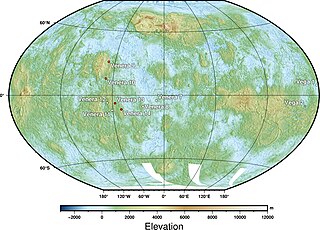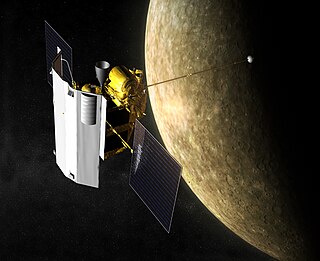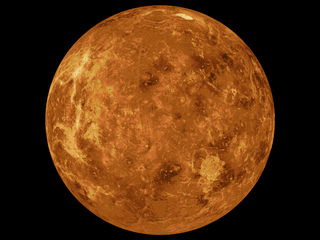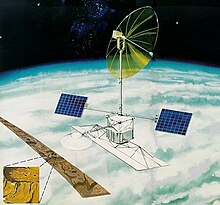
The Venera program was the name given to a series of space probes developed by the Soviet Union between 1961 and 1984 to gather information about the planet Venus.

Mars Express is a space exploration mission being conducted by the European Space Agency (ESA). The Mars Express mission is exploring the planet Mars, and is the first planetary mission attempted by the agency. "Express" originally referred to the speed and efficiency with which the spacecraft was designed and built. However, "Express" also describes the spacecraft's relatively short interplanetary voyage, a result of being launched when the orbits of Earth and Mars brought them closer than they had been in about 60,000 years.
Venera 4V-2 was a series of two identical spacecraft sent to Venus by the Soviet Union, consisting of Venera 15 and Venera 16. Both uncrewed orbiters were to map the surface of Venus using high resolution imaging systems. The spacecraft were identical and based on modifications to the earlier Venera space probes.

The Magellan spacecraft was a 1,035-kilogram (2,282 lb) robotic space probe launched by NASA of the United States, on May 4, 1989, to map the surface of Venus by using synthetic-aperture radar and to measure the planetary gravitational field.

Venera 16 was a spacecraft sent to Venus by the Soviet Union. This uncrewed orbiter was to map the surface of Venus using high resolution imaging systems. The spacecraft was identical to Venera 15 and based on modifications to the earlier Venera space probes. The latest data from the spacecraft were received on June 13, 1985, when it responded to the signal sent from Earth for Vega 1.
Venera 15 was a spacecraft sent to Venus by the Soviet Union. This uncrewed orbiter was to map the surface of Venus using high resolution imaging systems. The spacecraft was identical to Venera 16 and based on modifications to the earlier Venera space probes.

MESSENGER was a NASA robotic space probe that orbited the planet Mercury between 2011 and 2015, studying Mercury's chemical composition, geology, and magnetic field. The name is a backronym for "Mercury Surface, Space Environment, Geochemistry, and Ranging", and a reference to the messenger god Mercury from Roman mythology.

Synthetic-aperture radar (SAR) is a form of radar that is used to create two-dimensional images or three-dimensional reconstructions of objects, such as landscapes. SAR uses the motion of the radar antenna over a target region to provide finer spatial resolution than conventional stationary beam-scanning radars. SAR is typically mounted on a moving platform, such as an aircraft or spacecraft, and has its origins in an advanced form of side looking airborne radar (SLAR). The distance the SAR device travels over a target during the period when the target scene is illuminated creates the large synthetic antenna aperture. Typically, the larger the aperture, the higher the image resolution will be, regardless of whether the aperture is physical or synthetic – this allows SAR to create high-resolution images with comparatively small physical antennas. For a fixed antenna size and orientation, objects which are further away remain illuminated longer – therefore SAR has the property of creating larger synthetic apertures for more distant objects, which results in a consistent spatial resolution over a range of viewing distances.

Space-based radar or spaceborne radar is a radar operating in outer space; orbiting radar is a radar in orbit and Earth orbiting radar is a radar in geocentric orbit. A number of Earth-observing satellites, such as RADARSAT, have employed synthetic aperture radar (SAR) to obtain terrain and land-cover information about the Earth.

Observations of the planet Venus include those in antiquity, telescopic observations, and from visiting spacecraft. Spacecraft have performed various flybys, orbits, and landings on Venus, including balloon probes that floated in the atmosphere of Venus. Study of the planet is aided by its relatively close proximity to the Earth, compared to other planets, but the surface of Venus is obscured by an atmosphere opaque to visible light.

TerraSAR-X, is an imaging radar Earth observation satellite, a joint venture being carried out under a public-private-partnership between the German Aerospace Center (DLR) and EADS Astrium. The exclusive commercial exploitation rights are held by the geo-information service provider Astrium. TerraSAR-X was launched on 15 June 2007 and has been in operational service since January 2008. With its twin satellite TanDEM-X, launched 21 June 2010, TerraSAR-X acquires the data basis for the WorldDEM, the worldwide and homogeneous DEM available from 2014.

The surface of Venus is dominated by volcanic features and has more volcanoes than any other planet in the Solar System. It has a surface that is 90% basalt, and about 65% of the planet consists of a mosaic of volcanic lava plains, indicating that volcanism played a major role in shaping its surface. There are more than 1,000 volcanic structures and possible periodic resurfacing of Venus by floods of lava. The planet may have had a major global resurfacing event about 500 million years ago, from what scientists can tell from the density of impact craters on the surface. Venus has an atmosphere rich in carbon dioxide, with a density that is 90 times that of Earth's atmosphere.

The Lunar Reconnaissance Orbiter (LRO) is a NASA robotic spacecraft currently orbiting the Moon in an eccentric polar mapping orbit. Data collected by LRO have been described as essential for planning NASA's future human and robotic missions to the Moon. Its detailed mapping program is identifying safe landing sites, locating potential resources on the Moon, characterizing the radiation environment, and demonstrating new technologies.

Sentinel-1 is the first of the Copernicus Programme satellite constellation conducted by the European Space Agency. This mission was originally composed of a constellation of two satellites, Sentinel-1A and Sentinel-1B, which shared the same orbital plane. Two more satellites, Sentinel-1C and Sentinel-1D are in development. Sentinel-1B has been retired, leaving Sentinel-1A the only satellite of the constellation. The Sentinel-1 satellites carry a C-band synthetic-aperture radar instrument which provides a collection of data in all-weather, day or night. This instrument has a spatial resolution of down to 5 m and a swath of up to 410 km. The satellite orbits a Sun-synchronous, near-polar orbit. The orbit has a 12-day repeat cycle and completes 175 orbits per cycle.
Richard M. "Dick" Goldstein is an American radar astronomer and planetary scientist, who has been called "The Father of Radar Interferometry."

VERITAS is an upcoming mission from NASA's Jet Propulsion Laboratory (JPL) to map the surface of the planet Venus in high resolution. The combination of topography, near-infrared spectroscopy, and radar image data will provide knowledge of Venus's tectonic and impact history, gravity, geochemistry, the timing and mechanisms of volcanic resurfacing, and the mantle processes responsible for them.

The mapping of Venus refers to the process and results of human description of the geological features of the planet Venus. It involves surface radar images of Venus, construction of geological maps, and the identification of stratigraphic units, volumes of rock with a similar age.
Venus Origins Explorer (VOX) is a concept orbiter mission to Venus.

EnVision is an orbital mission to Venus being developed by the European Space Agency (ESA) that is planned to perform high-resolution radar mapping and atmospheric studies. EnVision is designed to help scientists understand the relationships between its geological activity and the atmosphere, and it would investigate why Venus and Earth took such different evolutionary paths. The probe was selected as the fifth medium mission (M5) of ESA's Cosmic Vision programme in June 2021, with launch planned for 2031. The mission will be conducted in collaboration with NASA, with the potential sharing of responsibilities currently under assessment.

The International-Mars Ice Mapper (I-MIM) mission is a proposed Mars orbiter being developed by NASA in collaboration with the Japan Aerospace Exploration Agency (JAXA), the Canadian Space Agency (CSA), and the Italian Space Agency (ASI). As the mission concept evolves, there may be opportunities for other space agency and commercial partners to join the mission. The goal of the orbiter is the quantification of extent and volume of water ice in non-polar regions of Mars. The results are intended to support future Mars missions, especially with respect to the search for habitable environments and accessible In situ resource utilization (ISRU) resources. The International-Mars Ice Mapper is an "exploration precursor mission", comparing it to the Lunar Reconnaissance Orbiter (LRO) mission. The mission was envisioned to be launched as early as 2026. However, in March 2022, it was revealed in its fiscal year 2023 budget proposal that the US government would terminate NASA financial support for the Mars Ice Mapper, casting the project's future into uncertainty.



















